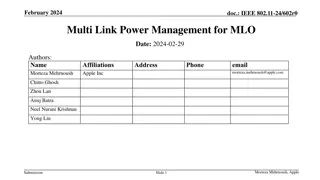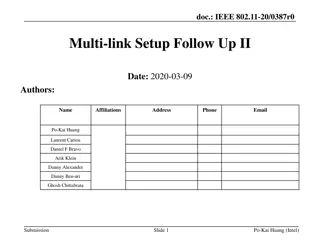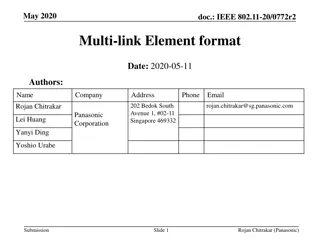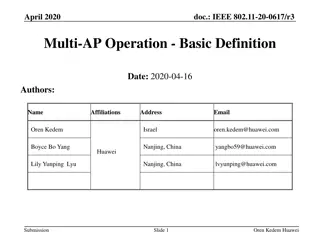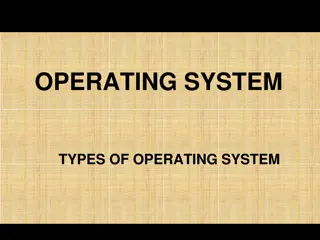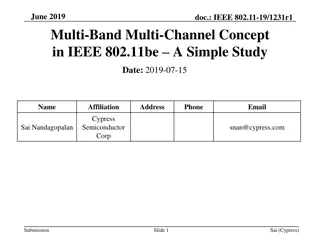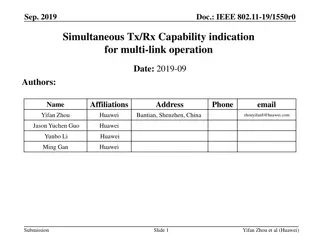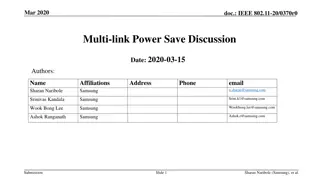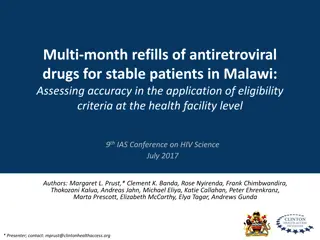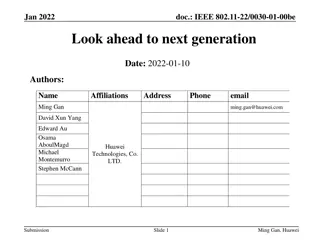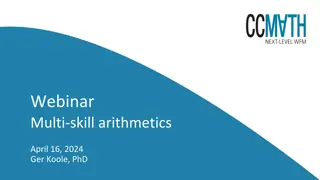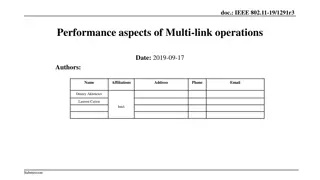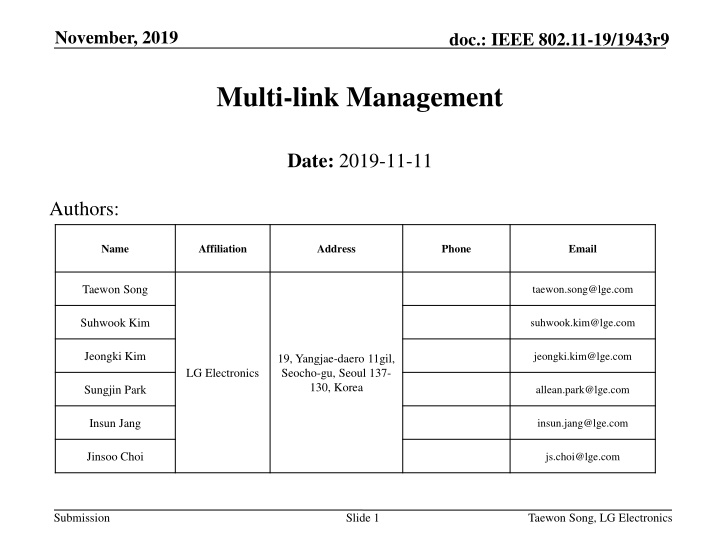
Channel and Link Switch Operations for Multi-link Management in IEEE 802.11
Explore the innovative channel and link switch operations proposed for effective multi-link management in IEEE 802.11 networks. Learn about solutions addressing traffic congestion, load balancing, and more to enhance network performance and efficiency.
Download Presentation

Please find below an Image/Link to download the presentation.
The content on the website is provided AS IS for your information and personal use only. It may not be sold, licensed, or shared on other websites without obtaining consent from the author. If you encounter any issues during the download, it is possible that the publisher has removed the file from their server.
You are allowed to download the files provided on this website for personal or commercial use, subject to the condition that they are used lawfully. All files are the property of their respective owners.
The content on the website is provided AS IS for your information and personal use only. It may not be sold, licensed, or shared on other websites without obtaining consent from the author.
E N D
Presentation Transcript
November, 2019 doc.: IEEE 802.11-19/1943r9 Multi-link Management Date: 2019-11-11 Authors: Name Affiliation Address Phone Email Taewon Song taewon.song@lge.com Suhwook Kim suhwook.kim@lge.com Jeongki Kim jeongki.kim@lge.com 19, Yangjae-daero 11gil, Seocho-gu, Seoul 137- 130, Korea LG Electronics Sungjin Park allean.park@lge.com Insun Jang insun.jang@lge.com Jinsoo Choi js.choi@lge.com Submission Slide 1 Taewon Song, LG Electronics
November, 2019 doc.: IEEE 802.11-19/1943r9 Motivation There have been lots of contribution dealing with multi-link management issues [1-3] Steering/load balancing, aggregation, AP power save, coexistence with other stds, QoS, etc. Channel/link switch operation would be one of solutions to avoid traffic congestion in multi-link In this contribution, we introduce channel/link switch operation for multi-link and address some considerations Submission Slide 2 Taewon Song, LG Electronics
November, 2019 doc.: IEEE 802.11-19/1943r9 Recap on terminologies [1-2] AP multi-link device (AP MLD) AP 1 AP 2 AP 3 Disabled multi-link set Link 1 Link 2 Link 3 Enabled multi-link set STA 1 STA 2 STA 3 Non-AP multi-link device (Non-AP MLD) Submission Slide 3 Taewon Song, LG Electronics
November, 2019 doc.: IEEE 802.11-19/1943r9 Channel switch operation in multi-link Channel switch operation is already defined in legacy .11 It can be performed by existing channel switch announcement Based on the channel switching procedure, AP2 and STAs which are associated with the AP2 move to other channel after the announcement With this channel switching, crowded channel can be avoided so that traffic load can be balanced Also, transmission on one link concurrent with reception on the other link may become possible In multi-link, channel switch operation may be used more frequently since established connections are still alive during switching Move to other channel AP MLD AP MLD AP 1 AP 2 AP 1 AP 2 Channel switch announcement Link 1 Link 2 Link 1 Link 2 STA 1 STA 2 STA 1 STA 2 Non-AP MLD Non-AP MLD Submission Slide 4 Taewon Song, LG Electronics
November, 2019 doc.: IEEE 802.11-19/1943r9 Link switch operation initiated from AP side An AP MLD may request a non-AP MLD so that the non-AP MLD can perform a link switch operation In this scenario, only a STA moves to other link supported by the AP MLD So, AP2 keeps providing access for other associated STAs as was An existing channel switch announcement can be reused with slight modification Link switch response from the non-AP MLD needs to be defined in order to let the AP MLD know when to switch transmitter AP Also, alive check procedure may be needed whether STA2 successfully moved or not Switch transmitter AP which transmits to STA2 AP MLD AP MLD AP 1 AP 2 AP 3 AP 1 AP 2 AP 3 1) Link switch request Link 1 Link 2 Link 1 Link 2 3) Alive check 2) Link switch response Move to other link supported by AP MLD STA 1 STA 2 STA 1 STA 2 Non-AP MLD Non-AP MLD Submission Slide 5 Taewon Song, LG Electronics
November, 2019 doc.: IEEE 802.11-19/1943r9 Link switch operation initiated from STA side On the other hand, a non-AP MLD may also request link switch operation A STA affiliated with a non-AP MLD may change its operating link among the links supported by an AP MLD Information for link to move may be informed by the AP MLD in advance To this end, link switch operation from STA side needs to be defined Same as earlier, alive check procedure may be needed whether STA2 successfully moved or not Switch transmitter AP which transmits to STA2 AP MLD AP MLD AP 1 AP 2 AP 3 AP 1 AP 2 AP 3 2) Link switch response Link 1 Link 2 Link 1 Link 2 3) Alive check 1) Link switch request Move to other link supported by AP MLD STA 1 STA 2 STA 1 STA 2 Non-AP MLD Non-AP MLD Submission Slide 6 Taewon Song, LG Electronics
November, 2019 doc.: IEEE 802.11-19/1943r9 Diagram for link switch operation AP MLD non-AP MLD After multi-link setup, STA1 and STA2 become associated with AP1 and AP2, respectively At multi-link setup stage, information can be exchanged between the MLDs, i.e., non-AP MLD can be aware of the existence of APs and their operating channels The AP MLD or the non-AP MLD initiates link switch operation as mentioned earlier Additional alive check operation may be performed to make sure that STA2 successfully switch its link After that, a new link is established between the AP and the STA During ML setup procedure, required information (e.g., supportable frequency band/channel) can be exchanged between AP MLD and STA MLD AP 1 AP 2 AP 3 STA 1 STA 2 Multi-link setup with information exchange Link 1 Link 2 Data transmission Link switch operation request/response Renew information of non-AP MLD Switch operating link Alive check operation Link 2 Data transmission Submission Slide 7 Taewon Song, LG Electronics
November, 2019 doc.: IEEE 802.11-19/1943r9 Link switch operation with STA s shared radio Due to spatial limitations in a physical device, some STAs affiliated with a MLD may support multiple frequency bands E.g., either 5 GHz or 6 Ghz band Assuming this, link switch operation would be used more efficiently in multi-link scenario Link switch procedure shown below can be done initiated either from AP MLD or from non-AP MLD AP MLD AP MLD AP 1 AP 2 AP 3 AP 1 AP 2 AP 3 2.4GHz 5GHz 6GHz 2.4GHz 5GHz 6GHz Link 1 Link 2 Link 1 Link 2 2.4GHz 5GHz/6GHz 2.4GHz 5GHz/6GHz Change its operating band and move to other link supported by AP MLD STA 1 STA 2 STA 1 STA 2 Non-AP MLD Non-AP MLD Submission Slide 8 Taewon Song, LG Electronics
November, 2019 doc.: IEEE 802.11-19/1943r9 Link switch operation with AP s shared radio For some APs with spatial limitation (e.g., Soft AP), these APs may operate with a shared radio as well APs affiliated with the AP MLD can operate either 5 GHz or 6 GHz However, as shown in figure below, legacy/single-link 5 GHz stations would lose their connections in this case AP MLD AP MLD AP 1 AP 2 AP 1 AP 2 2.4GHz 5GHz/6GHz 2.4GHz 5GHz/6GHz Lose connection 5GHz 5GHz STA A1 STA A1 Non-AP MLD A (No shared radio support) Non-AP MLD A (No shared radio support) 2.4GHz 5GHz/6GHz 2.4GHz 5GHz/6GHz STA B1 STA B2 STA B1 STA B2 Non-AP MLD B (Shared radio support) Non-AP MLD B (Shared radio support) Submission Slide 9 Taewon Song, LG Electronics
November, 2019 doc.: IEEE 802.11-19/1943r9 Link switch operation with AP s shared radio To overcome this disconnection problem of legacy STAs, a subset of links may remain in the frequency band where they originally existed For instance, assuming AP 1 has 4 antennas, the AP 1 is split into AP 1 and AP 2, and they are allocated on 5GHz and 6GHz, respectively STAs supporting shared radio (non-AP MLD B) can selectively move to a new AP (AP 2) Legacy STA can maintain its connection with the AP Since a BSS is newly activated, information regarding the BSS can be announced such as Band Information, Max # of Nss, BSSID, Beacon Interval, and so on Some attributes, e.g., Max # of Nss, for the remaining AP may be changed and they needs to be announced AP MLD AP MLD 4 antennas 2 antennas 2 antennas AP 1 AP 2 AP 1 AP 2 5GHz 6GHz 5GHz 6GHz 5GHz 5GHz STA A1 STA A1 Non-AP MLD A (No shared radio support) Non-AP MLD A (No shared radio support) 5GHz/6GHz 5GHz/6GHz STA B1 STA B1 Non-AP MLD B (Shared radio support) Non-AP MLD B (Shared radio support) Submission Slide 10 Taewon Song, LG Electronics
November, 2019 doc.: IEEE 802.11-19/1943r9 Considerations The AP MLD or the non-AP MLD can initiate link switch operation for non-AP MLD If some radios can be shared among frequency bands, link switch operation can be used adequately In this case, legacy/single-link devices may not be supported due to the switched band To support the legacy/single-link devices, a subset of links may remain on the link where they existed To this end, some additional information can be included in addition to existing channel switching Submission Slide 11 Taewon Song, LG Electronics
November, 2019 doc.: IEEE 802.11-19/1943r9 References [1] 19/0822r9, Extremely efficient multi-band operation [2] 19/1358r0, Multi-link operation management [3] 19/1528r2, Multi-link: Link management Submission Slide 12 Taewon Song, LG Electronics
November, 2019 doc.: IEEE 802.11-19/1943r9 Straw Poll 1 Do you agree to add the following text to the TGbe SFD? A non-AP MLD may send its associated AP MLD a frame to request to switch link to other link among enabled links of the AP MLD. Submission Slide 13 Taewon Song, LG Electronics
November, 2019 doc.: IEEE 802.11-19/1943r9 Straw Poll 2 Do you agree to add the following text to the TGbe SFD? An AP MLD may send an non-AP MLD a frame to request to switch a link of the non-AP MLD to other link among enabled links of the AP MLD. Submission Slide 14 Taewon Song, LG Electronics
November, 2019 doc.: IEEE 802.11-19/1943r9 Straw Poll 3 Do you agree to define the following? Single-link/radio (TBD) non-AP MLD: A non-AP MLD that supports operation on more than one link but can only listen, receive, or transmit frames on one link at a time. Submission Slide 15 Taewon Song, LG Electronics
November, 2019 doc.: IEEE 802.11-19/1943r9 Straw Poll 4 Do you agree to revise the SP text as follows? [SP#118] Single-link/radio (TBD) non-AP MLD: A non-AP MLD that supports operation on more than one link but can only listen, receive, or transmit frames on one link at a time. Cf. The reason why I revised it is that the meaning of listen is already incorporated in receive , and therefore this listen might be redundant. Submission Slide 16 Taewon Song, LG Electronics

